PANDAREN
 Panda people! The Pandaren is one of Azeroth's most enigmatic races. They hail from the comtinent of Pandaria. In the past, the pandaren were slaves of the race known as the mogu (and that's a really long story, so we'll skip that for when we actually have a pandaren-themed expansion) until they managed to throw off the shackles of slavery in a revolution. During the Great Sundering at the end of the War of the Ancients, Shaohao, the last pandaren emperor, sealed the continent of Pandaria behind a veil of mist, hiding Pandaria from the outside world for millennia, although a smaller civilization of pandaren wandered the world on a gigantic turtle known as the Shen-zin Su, the Wandering Isle, keeping Pandaria informed of the outside world.
Panda people! The Pandaren is one of Azeroth's most enigmatic races. They hail from the comtinent of Pandaria. In the past, the pandaren were slaves of the race known as the mogu (and that's a really long story, so we'll skip that for when we actually have a pandaren-themed expansion) until they managed to throw off the shackles of slavery in a revolution. During the Great Sundering at the end of the War of the Ancients, Shaohao, the last pandaren emperor, sealed the continent of Pandaria behind a veil of mist, hiding Pandaria from the outside world for millennia, although a smaller civilization of pandaren wandered the world on a gigantic turtle known as the Shen-zin Su, the Wandering Isle, keeping Pandaria informed of the outside world.During the Third War, Pandaren would start to be seen on Azeroth, with the Pandaren Brewmaster heroes that sometimes appeared in taverns, working tirelessly to perfect their brews. One such figure was Chen Stormstout, who allied himself with Rexxar and Rokhan, heroes of the Horde, and was instrumental in helping to found Orgrimmar.
 During the Cataclysm, the protective mists around Pandaria began to break down, and this caused Alliance and Horde warships to arrive on the continent during Mists of Pandaria and renew their conflict there, drawing the native pandaren into the conflict. The resulting battle and clash of ideals casued the Tushui sect of pandaren to swear allegiance to the Alliance, while the Huojin joined the Horde. (Player characters who played as pandaren can choose to join Tushui or Huojin at a certain level). The Pandaren would also spread the ways of the monk to races of the Alliance and Horde. Pandaria would become a bloody battleground between Alliance and Horde, as well as the threats that long lay dormant on the land -- the swarm of mantid, the resurrected mogu emperor Lei Shen, and the Sha, sleeping echoes of the dead Old God Y'Shaarj. The latter became the source of power for the mad orc warchief Garrosh Hellscream, who was eventually defeated by the combined might of the Alliance, Horde and the Pandaren people. The Pandaren would also serve as the hosts of the great trial of Garrosh after the crisis.
During the Cataclysm, the protective mists around Pandaria began to break down, and this caused Alliance and Horde warships to arrive on the continent during Mists of Pandaria and renew their conflict there, drawing the native pandaren into the conflict. The resulting battle and clash of ideals casued the Tushui sect of pandaren to swear allegiance to the Alliance, while the Huojin joined the Horde. (Player characters who played as pandaren can choose to join Tushui or Huojin at a certain level). The Pandaren would also spread the ways of the monk to races of the Alliance and Horde. Pandaria would become a bloody battleground between Alliance and Horde, as well as the threats that long lay dormant on the land -- the swarm of mantid, the resurrected mogu emperor Lei Shen, and the Sha, sleeping echoes of the dead Old God Y'Shaarj. The latter became the source of power for the mad orc warchief Garrosh Hellscream, who was eventually defeated by the combined might of the Alliance, Horde and the Pandaren people. The Pandaren would also serve as the hosts of the great trial of Garrosh after the crisis.(A bit of a meta history -- the Pandaren began life as an easter egg throughout the creation of Warcraft III, with several easter eggs in the campaign showing flashes of pandaren artwork or furbolg enemies repainted in a panda-theme called 'pandaren'. The reaction to the pandaaren was overwhelming, and the race was canonized in the expansion pack and given a backstory.)

Youthful Brewmaster/Ancient Brewmaster: Pandaren Brewmasters were the only representative of the Pandaren race in Warcraft III, first introduced in the expansion pack, Frozen Throne. The Brewmasters wander the world in search for exotic ales and ingredients, and while generally a peaceful people, when push comes to shove they do battle with a combination of their powerful martial arts and using their liquor in battle. They are able to breathe fire, drench enemies in alcohol and slow them down (and make them burn even brighter when hit with fire), dodge attacks with their drunken fighting and, as their ultimate, split themselves into three spirits of Storm, Earth and Fire, each with their respective abilities. In WoW, Brewmaster is one of the possible specializations for the Monk class. The artwork for the Youthful Brewmaster actually depicts Chen Stormstout, the Horde-aligned Pandaren Brewmaster from Warcraft III. The Ancient Brewmaster's two quotes "I'll put it on your tab" and "Another round?" are quotes spoken by the Pandaren Brewmaster unit in Warcraft III.
_____________________________________________________________
Demons
 Demons (daemons in Warcraft I) are immortal beings that come from the vile realm of the Twisting Nether. They are brutal creatures with no compassion and delight in causing suffering and destruction. As the lore behind demons are expanded upon in novels, and ultimately Warcraft III and World of Warcraft, we learn that the demons of the Burning Legion are creatures corrupted by fel energy, and they have immortal souls and all demons will have their spirits returned to the realm of the Twisting Nether after being slain, reforming there and potentially returning to the world. The only way to permanently kill a demon is to kill them inside the Nether, or in places seeped in chaotic energy. The vast majority of demons are part of the incomprehensibly large, worlds-spanning Burning Legion under the fallen titan Sargeras. Since Warcraft III onwards, there have been multiple different types of demons.
Demons (daemons in Warcraft I) are immortal beings that come from the vile realm of the Twisting Nether. They are brutal creatures with no compassion and delight in causing suffering and destruction. As the lore behind demons are expanded upon in novels, and ultimately Warcraft III and World of Warcraft, we learn that the demons of the Burning Legion are creatures corrupted by fel energy, and they have immortal souls and all demons will have their spirits returned to the realm of the Twisting Nether after being slain, reforming there and potentially returning to the world. The only way to permanently kill a demon is to kill them inside the Nether, or in places seeped in chaotic energy. The vast majority of demons are part of the incomprehensibly large, worlds-spanning Burning Legion under the fallen titan Sargeras. Since Warcraft III onwards, there have been multiple different types of demons.The greatest invasions of the Burning Legion in Azeroth happened several times -- the first during the War of the Ancients, when reckless experimentation by the night elven queen Azshara caused the titular war, nearly causing the destruction of Azeroth as the armies of the Burning Legion poured through, and the resulting war caused the implosion of the Well of Eternity and the splitting of the once-whole continent of Kalimdor.
Prior to the First War, Azeroth was guarded by the Guardian of Tirisfal, and greatest among these is Aegwynn, who succeeded in stopping the arrival of the demon lord Sargeras. However, Sargeras planted his essence into Aegwynn's body and corrupted her unborn son, Medivh -- who would become guardian after her. Medivh's corruption allowed Sargeras to manipulate him, and Medivh would meet his end as a possessed pawn of the demons, allowing the servants of the demons -- the orcish Horde -- to enter and slaughter humans. The demons are also behind the corruption of the orcs and tainting them with bloodlust, and are ultimately the masterminds behind Gul'dan's machinations to cause the First and Second War.
During the First War, Warlock units are able to summon Daemons to fight on their behalf, while in Warcraft II Daemons are neutral-aligned creatures that populate the Tomb of Sargeras. In Warcraft III, the Third War and the conflict caused by the rise of the plague of undeath and the Scourge is all merely a prologue for agents of the Scourge to summon the demon lord Archimonde into the world of Azeroth. While Archimonde and his generals are ultimately repelled in various battles during the Third War, it was not without great cost and destruction. Throughout World of Warcraft, demons have been at the forefront of many conflicts, particularly during the Burning Crusade expansion, and in the newest Legion expansion, the Burning Legion finally makes their biggest entrance into Azeroth.


Blood Imp/Flame Imp: Imps are the weakest demons, introduced in World of Warcraft as the starting, weakest possible pet that a warlock can summon. Imps are also the minions of many other demon-allied forces like satyrs and warlock cults. They are mischievous and vile, cackling madly as they unleash destruction as ordered by the warlock. No specific imp mob was called a 'Blood Imp', though. The Flame Imp is the name of an enemy found in the Molten Core dungeon, and indeed the imp's basic attack are blasts of fire. The quotes of the Blood Imp ("do I have to" and "sure, send the little guy!") and the Flame Imp's ("yeah, I'll get right on it!" and "is this really necessary?") are taken from the oft-quoted imp minion in WoW.


Succubus: Succubi (otherwise known as Sayaadi) was first introduced as neutral enemies in Warcraft III: the Frozen Throne, often in service to agents of the Burning Legion. Succubi resemble scantily clad women with bat-like wings and horns, and they revel in the arts of pain and pleasure. They tempt lesser, weaker species with lust, and act as interrogators for the Burning Legion. The Succubus is the third demonic minion that a Warlock in World of Warcraft can summon, dealing more damage than the imp, able to use her abilities to crowd control, but is more fragile than the Voidwalker.


Voidwalker: Voidwalkers are a type of demons found in Outland in Warcraft III: The Frozen Throne. The WC3 version of Voidwalkers were different than the Voidwalkers of WoW, having an elongated, skull-like face and visible ribs. In WoW, Voidwalkers are one of the possible demons that a warlock can summon, and the Voidwalkers in WoW look identical to how they are in the card arts -- hulking, genie-like with armour around their arms. Voidwalkers are slower, but far more durable with more health. Voidwalkers do not feel pain, and their touch is as cold as death. Despite being classified as demons in the game, and summonable by warlocks, some sources note that the Voidwalkers aren't exactly demons per se but are creatures that reside in the Void (the type of magic that shadow priests use, as opposed to the fel magic that demons and warlocks use). Lastly, their two quotes are also taken verbatim from the quotes of the Voidwalker pet in WoW.





Felguard: Felguard are introduced in Warcraft III: The Frozen Throne, being muscular red or blue-skinned humanoids with spiky black armour that serve as shock troops of the Legion. In World of Warcraft, they are identified as members of the Mo'arg race of demons, serving as the Legion's rank-and-file troops. In WoW the Felguard is one of the possible minions that a Warlock can summon, and both his voice-over lines in Hearthstone is taken verbatim from the Felguard pet in WoW. Various mobs in WoW are simply called "Felguard".

Void Terror: The Void Terror is the name of an enemy found in Blade's Edge Mountains in Burning Crusade, and is a member of the Void Hound race. Void hounds are two-headed demon hounds with multiple eyestalks protruding from its back. Void hounds are some of the rarest demons, and prior to the Burning Crusade the only void hound known to Azeroth was Immol'thar, a creature bound in Dire Maul. After Burning Crusade, many more void hounds were found in Outland.





Summoning Portal: We'll lump this thing here, but summoning portals (which tends to have the shape of wraithlike hands holding open a door) are often used by warlocks and members of the Burning Legion to bring forth reinforcements in the form of demons, or, in WoW, other players.
_____________________________________________________________
Dragons
 |
| Five dragonflights (WoW) |
A lot of the lore behind dragons of Azeroth are a bit impossible to discuss without discussing the five Dragon Aspects, which I'll discuss in the legendary minions section. But to make things short, dragons are powerful, sentient magical creatures that are divided into five dragonflights. They are given their power by the mighty titans, given domain over a certain aspect of the world. Alexstrasza of the red dragonflight was given power over life. Malygos of the blue, over magic. Nozdormu of the bronze, over time. Ysera of the green, over dreams and nature. And lastly, Neltharion of the black, over earth. Neltharion would become rogue, driven into evil, and rename himself as Deathwing, slaughtering a large portion of the blue dragonflight and driving Malygos insane. Throughout the history of Azeroth, the dragon aspects and their power over the various aspects of the world would be instrumental in shaping the fate of Azeroth.
In the Second War, the dragons would be involved in the Alliance/Horde conflict when, with the unseen aid of the treacherous Deathwing, the orcs of the Dragonmaw and Black Tooth Grin clan were able to subjugate the dragon queen Alexstrasza and steal her young to raise them as minions of the Old Horde, although a force led by Alexstrasza's mate Korialstrasz was able to free the dragon queen. During the events of Beyond the Dark Portal, Deathwing's black dragonflight, and Deathwing himself, would ally themselves with the Horde. (Even if all dragons were rendered green thanks to engine limitations in Warcraft II). In Warcraft III, the aspects took no part in the war, but multiple independent dragons battled various forces throughout the Third War.
In World of Warcraft, and especially Cataclysm (where Deathwing returned with an army and shattered a large chunk of Azeroth), the dragons and the lore behind them are absolutely crucial in the many, many crises that gripped the world... but we'll go over those later.


Twilight Drake: The twilight dragonflight is a small group of dragons created during the Wrath of the Lich King due to the experiments of the black dragon Sintharia, consort to Deathwing. The twilight dragonflight are created by exposure of nether dragon eggs to various other draconic artifacts, creating a new dragonflight that was able to feed off the magic of other dragons vampirically, and temporarily turn incorporeal. More twilight dragons would be created by Deathwing's minions, the Twilight's Hammer cult, in Cataclysm and Legion. The 'Twilight Drake' is the name of not a specific mob, but a mount in WoW.


Faerie Dragon: Faerie Dragons, despite their name... aren't actually dragons! They are intelligent lizard-esque fairies with butterfly wings that hail from the Emerald Dream, and are introduced as part of the night elven forces in Warcraft III: the Frozen Throne, and are the anti-spellcaster units that are able to phase shift, moving out of existence to avoid taking damage. They are also able to unleash mana flare, damaging spellcasting enemies, as well as being immune to any sort of negative magic themselves, the inspiration behind the Hearthstone card. After the Third War, the vast majority of Faerie Dargons have returned to the Emerald Dream, although some remained on Azeroth in areas associated with the Emerald Dream or the night elves.
Emerald Dragon: Emerald Dragon, the token created by Ysera, is, well, a dragon of the green dragonflight. The dragonflight itself is closely tied to the Emerald Dream, which is probably where this dragon draws its name from. The artwork is taken from the TCG artwork of Eranikus, Ysera's primary consort prior to his death in World of Warcraft: Cataclysm where he heroically died holding off the four Dragons of Nightmare, allowing Ysera and Malfurion to escape.
_____________________________________________________________
NEUTRAL CREATURES:
MURLOCS:
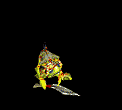
Now that the two bigger factions in the 'other' section, the dragons and the legion are done, we're going to break up the rest of the creatures and monsters of Azeroth by their species. First up, we have the famous, iconic murlocs. The murlocs are iconic creatures in the Warcraft franchise, first introduced in Warcraft III as a tribe of bipedal fish-people that worshipped a far mightier deity, in a little homage to the Deep Ones from the Cthulhu Mythos, first appearing in the first campaign in Warcraft III, assaulting and abducting the Darkspear trolls, which would lead to the formation of the New Horde when Thrall's orcs came to their aid. The murlocs continued to appear throughout most of the Warcraft III campaigns, with their most significant appearance being the Mur'gul tribe utilized with the Illidari-allied naga as labourers and shock troopers.
In World of Warcraft, murlocs have a relatively larger prominence, although were still relatively weak low-level enemies with a couple of notable exceptions. Multiple different tribes of murlocs were introduced in many different areas, including several variants of murlocs -- undead ones, as well as deep sea murlocs introduced in Cataclysm. Murlocs are reasonably intelligent, although brutish in culture.
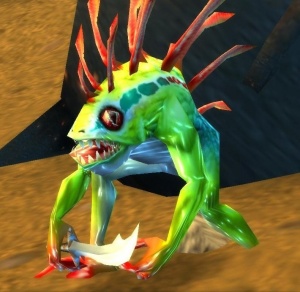
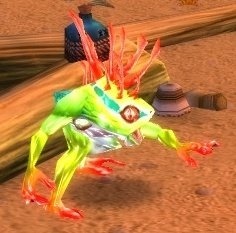
Murloc Raider: The Murloc Raider is the name of a level 10-11 murloc mob found in the Westfall area in World of Warcraft, and the Westfall Murlocs are part of a questline where an enterprising adventurer investigates the death of Furlbrow under the orders of Lt. Horatio Laine.
Murloc Tidehunter: Murloc Tidehunters are level 18-19 enemies in Westfall in World of Warcraft. The way the Murloc summons a fellow ally is similar to how Murlocs tend to behave in WoW -- attack one, and it will call upon its allies to help.


Murloc Tidecaller: The Murloc Tidecaller is a specific enemy Murloc in World of Warcraft, found in Lake Everstill in the Redridge Mountains. Murloc spellcasters are able to unleash a kind of crude shamanistic magic, with the Murloc Tidecaller being able to cast Frost Nova. The term 'Tidecaller' is used not only among murlocs, but also other races like makrura (Makrura Tidecaller is a unit in Warcraft III) to denote a spellcaster channeling the power of the sea.


Murloc Raider: The Murloc Raider is the name of a level 10-11 murloc mob found in the Westfall area in World of Warcraft, and the Westfall Murlocs are part of a questline where an enterprising adventurer investigates the death of Furlbrow under the orders of Lt. Horatio Laine.
Murloc Tidehunter: Murloc Tidehunters are level 18-19 enemies in Westfall in World of Warcraft. The way the Murloc summons a fellow ally is similar to how Murlocs tend to behave in WoW -- attack one, and it will call upon its allies to help.


Murloc Tidecaller: The Murloc Tidecaller is a specific enemy Murloc in World of Warcraft, found in Lake Everstill in the Redridge Mountains. Murloc spellcasters are able to unleash a kind of crude shamanistic magic, with the Murloc Tidecaller being able to cast Frost Nova. The term 'Tidecaller' is used not only among murlocs, but also other races like makrura (Makrura Tidecaller is a unit in Warcraft III) to denote a spellcaster channeling the power of the sea.
Grimsacle Oracle: The Grimscale tribe of murlocs found in the Eversong Woods, the blood elf starting area, as well as some undead Grimsacle members in the Ghostlands. The Grimscale Oracle is a mob found in the Eversong Woods.

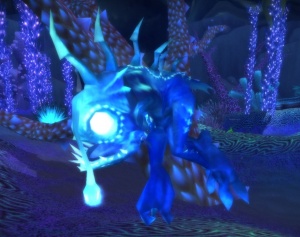
Coldlight Oracle: The Coldlight tribe is a group of deep sea murlocs, a new breed of murlocs added in the Cataclysm expansion, which had glassy eyes, a lure and a different type of spinal fin compared to regular murlocs, found in deep-sea areas like the Abyssal Depths. The Coldlight Oracles are specific level 81 enemies found there.
The following aren't based on any specific mobs in World of Warcraft: Murloc Warleader, Coldlight Seer.
_____________________________________________________________
OGRES:
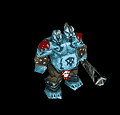
Ogres were introduced in Warcraft I as neutral enemies who came out of the Dark Portal alongside the orcs, but were not allied with them. While sentient, the ogres are generally brutish and simple-minded. The ogre Turok absconded with Griselda, the daughter of the Horde warchief, and was slaughtered by the orcish Horde. Warcraft II would reveal that the ogres are also native to the orcs' homeland of Draenor, and prior to the First War, they were often engaged with the orc tribes for war and territory. By the time the Second War happened, however, the orc warlock Gul'dan made an alliance with the ogres, and using a stolen elven artifact, elevated a large amount of them into powerful ogre magi, fearsome two-headed spellcasters. During the Second War, some particularly intelligent ogres like Mogor and Cho'gall led tribes among the Horde -- Laughing Skull and Twilight's Hammer respecticvely. When the Old Horde was disbanded at the end of the Second War, the ogres, like the Amani trolls and goblins, abandoned their orc allies. Two-headed ogres tended to have differing personalities across their two heads.
Throughout the Third War, the ogres have spread out all over Azeroth and became relatively commonplace, with one-headed and two-headed variants being relatively common sights in Azeroth, although the Horde champion Rexxar did manage to get the Stonemaul tribe of ogres, living in Durotar, to submit to the Horde after defeating their chieftain. Throughout World of Warcraft, the ogres remained dumb brutes found throughout the land, although some specific ogres like Cho'gall had major roles to play. The alternate ogres in the Warlords of Draenor timeline were part of the Gorian Empire (which was destroyed by the orcish Horde in the main timeline) and allied with the Iron Horde, but were ultimately defeated by the Alliance and the Horde.


Ogre Magi: Ogre Magi are generally blue-skinned, two-headed ogres first introduced in Warcraft II. During the course of the Second War, the orc warlock Gul'dan used a ritual to transform a large amount of ogres (including his apprentice Cho'gall) into two-headed ogres, elevating their intelligence and allowing them to use powerful spells like Bloodlust and the Eye of Kilrogg. In Warcraft III, Ogre Magi returned as neutral creeps, able to cast bloodlust to empower their allies. The artwork for the Ogre Magi card in Hearthstone depicts Mogor, who would get a legendary card in the GvG expansion.

Boulderfist Ogre: The Boulderfist Ogre is a level 32-33 mob found in Arathi Highlands in World of Warcraft, and a member of the Boulderfist tribe, who is a tribe of ogres that settled in Arathi Highlands in Azeroth, as well as Nagrand in Outland. The Boulderfist ogres are apparently among the ogre tribes that allied with the Old Horde during the Second War. In World of Warcaraft, the Boulderfists, now led by the half-orc, half-draenei Lantresor, would recruit adventurers to battle against their rivals of the Warmaul clan.
_____________________________________________________________
ANCIENTS (and the Keeper):
The Ancients are introduced in Warcraft III, and are giant, sentient trees that serve as the buildings for the Night Elven forces. Unlike the castles and keeps built by the other races, the Night Elves instead create Ancients, which, when needed, can uproot and move around and plant themselves elsewhere. Or whack enemies in the head with their big tree hands. In World of Warcraft, Ancients are obviously found mostly in Night Elven areas, although corruption has caused many corrupted Ancients to become hostile enemies. There are multiple kinds of Ancients in Warcraft III (Tree of Life, Ancient Protector, and Ancients of War, Lore, Wind and Wonders) but only a few show up in WoW, with the rest apparently suffering extremely heavy losses during the Third War and are hibernating to repopulate.

Ironbark Protector: The Ironbark Protector, despite its flavour text, shares its name with the corrupted, satyr-aligned ancient protectors of Dire Maul, a dungeon in World of Warcraft. The flavour text seems to imply that the Ironbark Protector are just a member of the many Ancient Protectors that guard the night elven capital of Darnassus. Ancient Protectors in Warcraft III serve as the defensive tower buildings of the night elven race, hurling boulders at enemies, or whacking people with their large arms, the Ancient Protectors serve true to their name by protecting their charges from harm.



Ancient of Lore: In Warcraft III, Ancients of Lore are ancients with orange-yellow leaves, holding a gigantic walking stick with a lantern on top. They are described as keepers of wisdom that can connect with nature's most guarded secrets, training night elves about the ways of magic and the secrets of nature. In Warcraft III the Ancient of Lore is the building with which night elven forces can train Dryads, Mountain Giants and Druids of the Claw. In WoW, Ancients of Lore can be found in various night elven settlements, mostly on a quest-giving capacity.




Ancient of War: In Warcraft III, the Ancient of War is one of the first Ancients that the Night Elven forces can build, and is the basic barracks-esque building that trains Archers, Huntresses and Glaive Throwers. They are distinguished by the gigantic tusks that jut out of their craggy faces. In World of Warcraft, Ancients of War are also true to their name by acting in a more offensive and defensive capacity, with many Ancients of War participating in battles. The mechanics of the Ancient of War in Hearthstone, rooting and uprooting, refers to how Ancients are unique buildings who can either root themselves and become buildings, or uproot and move around, but have less armour.


Keeper of the Grove: The Keeper of the Grove isn't exactly an Ancient, but it's still a race that is highly affiliated with the night elves, and I'll lump him here. The Keepers of the Grove are half-night-elf, half-stag descendants of the nature demigod Cenarius. Not to be confused with the Centaur race, who are the bastard offspring of a Keeper and an Earth Elemental. Possessing powerful mastery of druidic nature magic, and an arm made of wood, the Keepers of the Grove, as befits their name, are some of the mightiest protectors of the land. Alongside their Dryad sisters (a Dryad is represented in Hearthstone in the Laughing Sister uncollectible card, created by Ysera), the Keepers of the Grove are some of the greatest assets in the night elven army during the Third War. In Warcraft III, the Keeper of the Grove is one of the four hero units that a night elven force can use, with the abilities Entangling Roots, Force of Nature, Thorns Aura and Tranquility. Malfurion Stormrage is also classified as a Keeper of the Grove for practicality's sake, despite being a full night elf himself. While Keepers of the Grove can be found in WoW, they are relatively more rare. The Keeper of the Grove's Hearthstone quotes, "I must safeguard the land" and "fear nature's wrath" are the unit-ready and attack quotes of the Keeper of the Grove in Warcraft III. Various Keeper NPC's are simply noted as 'Keeper of the Grove'.

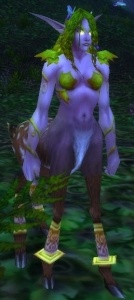
Laughing Sister: Laughing Sister, the token created by the Ysera card, is a dryad. Dryad are the daughters of Cenarius, and are basically female versions of the keepers of the grove. They are introduced in Warcraft III and are trained in the Ancient of Lore building. Unlike the Keepers, they are unable to do the powerful nature magic that their brothers can, but they have an immunity to magic (likely what inspired the card's effect) and able to abolish the magic of enemies. Laughing Sisters are level 31 dryad mobs in Ashenvale.


Treant: A lot of druid cards summon treants, and treants are smaller, primitive versions of the wise Ancients. In Warcraft III, Keepers of the Grove are able to transform nearby trees into treants to fight alongside him, a skill that is retained in World of Warcraft for druids. Independent treants exist, walking around usually in night elven or druidic areas.


Laughing Sister: Laughing Sister, the token created by the Ysera card, is a dryad. Dryad are the daughters of Cenarius, and are basically female versions of the keepers of the grove. They are introduced in Warcraft III and are trained in the Ancient of Lore building. Unlike the Keepers, they are unable to do the powerful nature magic that their brothers can, but they have an immunity to magic (likely what inspired the card's effect) and able to abolish the magic of enemies. Laughing Sisters are level 31 dryad mobs in Ashenvale.


Treant: A lot of druid cards summon treants, and treants are smaller, primitive versions of the wise Ancients. In Warcraft III, Keepers of the Grove are able to transform nearby trees into treants to fight alongside him, a skill that is retained in World of Warcraft for druids. Independent treants exist, walking around usually in night elven or druidic areas.
____________________________________________________________
ELEMENTALS:
 The last big race we'll be talking about in this article is the Elementals. They are spirits that embody one of the big four elemental energies of the land -- Fire, Water, Air and Earth, the four basic shamanistic elements that surge through the lands of Azeroth and Draenor, living in elemental planes, and are the manifestations of the elements themselves. Led by powerful Elemental Lords, many lesser, sometimes-unthinking, elementals can be found all throughout Azeroth, summoned into this world where the powers of the elements are strong, or bound to service by casters like mages and shamans.
The last big race we'll be talking about in this article is the Elementals. They are spirits that embody one of the big four elemental energies of the land -- Fire, Water, Air and Earth, the four basic shamanistic elements that surge through the lands of Azeroth and Draenor, living in elemental planes, and are the manifestations of the elements themselves. Led by powerful Elemental Lords, many lesser, sometimes-unthinking, elementals can be found all throughout Azeroth, summoned into this world where the powers of the elements are strong, or bound to service by casters like mages and shamans.
Once, the four Elements raged and ruled over the primordial parts of Azeroth, thanks to the rather conventional way of how Azeroth was formed, and the four Elemental Lords Al'Akir, Ragnaros, Neptulon and Therazane fought for territory until they were subjugated and enslaved by the Old Gods when they arrived on Azeroth. When the Titans came to bring order to Azeroth, the Elementals were banished to Elemental Planes, remaining there until summoned to Azeroth by some means. During the first three wars, very few Elementals appeared on Azeroth other than Water Elementals summoned by powerful mages, or independent Fire and Water Elementals. Yet throughout World of Warcraft, the Elementals grew more and more chaotic and powerful, until it came to a gigantic head in Cataclysm where the elements were torn asunder by the arrival of Deathwing and his recruitment of Ragnaros the Firelord and Al'Akir the Windlord under his wing.
While the majority of Elementals are one of the four main elements (Fire, Water, Earth and Air), there are certain exceptions which will be covered at the end of this section.


Magma Rager: Magma Ragers are revenant-type fire elementals found in the dungeon of Ulduar, although the artwork for the Hearthstone card depicts a bound fire elemental. Fire revenants are just a more powerful type of fire elementals, whereas bound elementals are elemental variants introduced in the Cataclysm expansion which has been enslaved by the Twilight's Hammer Cult, changing their appearances with elementium bindings.
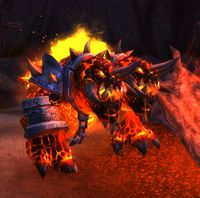
Core Hound: Despite being classified as a beast, core hounds are actually a type of fire elementals, although hunters in World of Warcraft are able to tame Core Hounds with specific exotic pet taming skills. Core Hounds take the appearance of savage, tw:o-headed giant dogs made out of molten lava, and are first introduced in World of Warcraft's Molten Core dungeon, with a specific mob called 'Core Hound'.


Molten Giant: Despite not being classified as such in Hearthstone, Molten Giants are fire elementals in World of Warcraft. They are enormous, brutish and powerful fire elementals that take a form similar to the Mountain Giants (but on FIRE!) and are native to the Firelands. Some arrive into Azeroth in places where the influence of the Fire Elementals are strong, such as Molten Core. Specific mobs called Molten Giant are level 60 mobs in the Molten Core.



Water Elemental: The Water Elementals hail from the Abyssal Maw, the realm ruled by Neptulon beneath the seas of Azeroth. Water Elementals appeared all the way in Warcraft I, where they are a powerful unit that can be summoned by the Mages of the Human race. In Warcraft III, the Archmage heroes are able to summon powerful Water Elementals as a temporary ally, and wild, unaligned Water Elementals can be found in several places. Similar to the mages of the RTS games, in World of Warcraft, Frost-specialized mages aer able to summon a Water Elemental minion as a pet, which can freeze the enemy with a spell -- something that explains why the Water Elemental is able to do such a thing in Hearthstone.
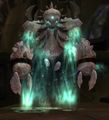

Frost Elemental: Frost Elementals are a subtype of water elementals which are, well, frozen. Channeling the power of frost and ice, the frost elementals inhabit the frozen wastes of Azeroth. While no mobs are called 'Frost Elemental' specifically, the mob 'Frozen Elemental' is found in the Borean Tundra area of WoW. Lastly, the artwork for Frost Elemental depicts Lokholar, the ice Lord, a massive ice elemental summoned by Horde forces in Alterac Valley. (No specific mob is called Frost Elemental).


Earth Elemental: Earth Elementals hail from the plane of Deepholm, led by the mighty Therazane, the Stonemother. First appearing in World of Warcraft, Earth Elementals are sturdy and unyielding, and are found in many parts of Azeroth. Their biggest role to play came during the events of Cataclysm, where Deathwing emerged from Deepholm into Azeroth, causing a large upheaval within the plane of Deepholm where Deathwing's Twilight Hammer minions attempted to wrestle the right to rule Deepholm from Therazane, the Stonemother enlists adventurers to help in her crusade to maintain her reign.

Dust Devil: Dust Devils are weak air elementals that could be found in the region of Westfall. Air elementals, introduced in World of Warcraft, are swirling, sentient beings of air that serve the mighty Al'Akir. During the Cataclysm, the Dust Devils of Westfall are transformed into Unbound Cyclones.

Lightspawn: The Lightspawn, and indeed, Light Elementals in general, actually debuted in Hearthstone, and are added to World of Warcraft relatively recently, in the Legion expansion, with the Champion of Light called Sol, the Lightspawn, being introduced. While most Elementals are one of the four primary types (or a combination thereof), the Lightspawn are created by the power of the Holy Light. Actual mobs called Lightspawn are level 98-100 mobs in the Netherlight Temple in Legion.


Mana Wraith: Mana Wraiths are a mob found in the Netherstorm. They are a type of Mana Elementals (sometimes known as arcane wraiths or mana surges) that superficially resemble the undead shades, but are actually being comprised completely of magical mana that arrive from the Twisting Nether or any other sufficiently powerful source of mana.
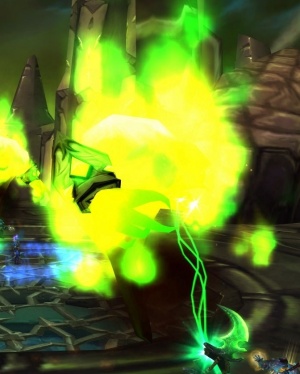
Flame of Azzinoth: Flames of Azzinoth are powerful entropic elementals -- basically elementals made out of fel fire instead of natural fire -- that Illidan Stormrage summons during his boss battle encounter in Burning Crusade. Azzinoth refers to Illidan's weapons, the Warglaives of Azzinoth, itself taking its name from the pit lord Azzinoth that Illidan slew and took the glaives from.

Flame of Azzinoth: Flames of Azzinoth are powerful entropic elementals -- basically elementals made out of fel fire instead of natural fire -- that Illidan Stormrage summons during his boss battle encounter in Burning Crusade. Azzinoth refers to Illidan's weapons, the Warglaives of Azzinoth, itself taking its name from the pit lord Azzinoth that Illidan slew and took the glaives from.
_____________________________________________________________
OTHER SENTIENT CREATURES:
This section will deal with the cards that represent members of a sentient race that, frankly, doesn't quite have enough representation in Hearthstone to really justify long, rambling articles. I'll try to be as succinct as I can in describing the specific races' history as quickly and briefly as I can.
This section will deal with the cards that represent members of a sentient race that, frankly, doesn't quite have enough representation in Hearthstone to really justify long, rambling articles. I'll try to be as succinct as I can in describing the specific races' history as quickly and briefly as I can.


Darkscale Healer: The Darkscale Healer is a female naga. The naga are a tribe of serpent-like creatures that are half-night-elf, half-sea-creature. Males of the species are far more mutated, hulking brutes, while females have four arms, the lower body of an eel or a snake, and prominent fins on their spine and head, while retaining much of their facial features. At the end of the War of the Ancients (see the night elf section), the cultists that serve Azshara were dragged down into the depths of the ocean during the implosion of the Well of Eternity. There, Queen Azshara made a pact with the Old God (presumed to be N'Zoth, although other sources claim that Azshara did it herself) and transformed her followers into naga, a race that can survive beneath the ocean. They were introduced during the Frozen Throne expansion of Warcraft III, rising out of the tides when called upon the renegade night elf, Illidan Stormrage, and served as one of Illidan's main forces throughout his campaign in Outland. The Darkscale Healer is a member of the Darkscale tribe, a group of naga that first appeared and battled the Horde and Alliance forces in Durotar during Warcraft III: The Frozen Throne, led by Lady Darkscale, and then again in World of Warcraft, found in Darkshore. No specific mob is called Darkscale Healer.




Windfury Harpy: Harpies are vile creatures that are half-woman, half-bird that populate the dusty wastelands of Kalimdor. Sadistic and brutish, the harpies enjoy killing or torturing any who trespass in their territory with their mastery of crude storm magic. Harpies were first introduced in Warcraft III, and in World of Warcraft are enemies in the starting zones of the orcs, trolls and tauren. The Windfury Harpy in particular is a mob in Mulgore, the tauren starting zone.







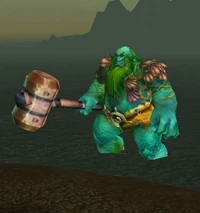
Sea Giant: The Sea Giants were first seen in Warcraft III: The Frozen Throne, where the night elves that explored the Broken Isles, as well as the members of the Horde taming the Echo Isles, met the mighty behemoths. The Sea Giants would be later established in World of Warcraft to be beings created by the Titans (more on the Titans later) to separate land from sea, and to guard the seas. In the present day, the Sea Giants have grown feral, and have grown to attacking ships to sink them. In battle, Sea Giants wear the remnants of the ships they have sunk, waving around anchors as their preferred weapon. Specific mobs called 'Sea Giant' are found in Desolace.


Mogu'shan Warden: Mogu'shan Wardens are the names of mobs found in the dungeon of Mogu'shan Vaults. The Mogu, briefly talked about in the Pandaren section, is a powerful, magical race that once ruled Pandaria and enslaved the pandaren with an iron fist. While the Pandaren eventually overthrew their tyrannical masters, during the events of Mists of Pandaria, a coalition of trolls led by the Zandalari tribe, the ancient allies of the mogu, would resurrect the mighty mogu emperor Lei Shen, and bring terror to the pandaren. The mogu themselves took the chance of the Alliance and Horde upsetting the balance of power in Pandaria to descend down and do battle with their ancient enemy, the Pandaren. However, through the efforts of adventurers on both sides of the Alliance and Horde, the mogu would eventually be defeated. Specific mobs called Mogu'shan Warden are level 92 Mogu ghosts found in the Mogu'shan Vaults.

Ethereal Arcanist: Ethereal Arcanists are the name of level 63-65 hostile mobs found in Terokkar Forest, a zone in Outland. The Ethereal is a race first introduced in Burning Crusade, and are described as astral travelers who dwell within the Twisting Nether, yet not being demons themselves. They resemble humanoids made out of energy, wrapped with magical cloth and armour to keep them from flowing out. Ethereals are collectors and traders of arcane items, and are unscrupulous beings with no real loyalty beyond their desire for magical artifacts. While found mainly in Outland areas as both friendly NPCs and hostile enemies, some ethereal that are part of the organization called the Consortium, a trade-driven group, are friendly to those members of Alliance and Horde who would do business with them.


Mogu'shan Warden: Mogu'shan Wardens are the names of mobs found in the dungeon of Mogu'shan Vaults. The Mogu, briefly talked about in the Pandaren section, is a powerful, magical race that once ruled Pandaria and enslaved the pandaren with an iron fist. While the Pandaren eventually overthrew their tyrannical masters, during the events of Mists of Pandaria, a coalition of trolls led by the Zandalari tribe, the ancient allies of the mogu, would resurrect the mighty mogu emperor Lei Shen, and bring terror to the pandaren. The mogu themselves took the chance of the Alliance and Horde upsetting the balance of power in Pandaria to descend down and do battle with their ancient enemy, the Pandaren. However, through the efforts of adventurers on both sides of the Alliance and Horde, the mogu would eventually be defeated. Specific mobs called Mogu'shan Warden are level 92 Mogu ghosts found in the Mogu'shan Vaults.


Chillwind Yeti: Yetis aren't exactly beasts, but are clearly not sentient. They are muscular humanoids who live in icy mountains. First introduced in Warcraft III as Wendigos, in World of Warcraft they are renamed as yetis. Three variants of yeti exist -- the more humanoid one as seen in the Hearthstone card is common in the two main continents of Azeroth. A far more gorilla-esque creature with gigantic horns is seen during Wrath of the Lich King in Northrend, and a third, spikier version of the Northrend variant seen in Pandaria during the events of Mists of Pandaria. The location Chillwind Point is a small rise on the eastern side of the Alterac Mountains range. To the best of what I can find, no yetis are there in WoW.
_____________________________________________________________
BEASTS:
Beasts, now! The beasts of Azeroth probably need less introduction since unless so noted, they are identical to beasts in our own world. But we're going to go through all the basic and classic cards, and I do mean every single one.
Beasts, now! The beasts of Azeroth probably need less introduction since unless so noted, they are identical to beasts in our own world. But we're going to go through all the basic and classic cards, and I do mean every single one.

Stonetusk Boar: The Stonetusk Boar is, obviously, a boar. They are based on the level 4-21 Stonetusk Boars that roam Elwynn Forest, the human starting zone in World of Warcraft. Boars are found in various places all over WoW. Their attack is actually called 'rushing charge'!


Bloodfen Raptor: The raptors (and indeed, dinosaurs in general) are introduced in World of Warcraft, and the raptors have since became synonymous with the troll race, who were given the raptors as their signature mounts and starting pet. Raptors are found on both Azeroth and Outland. The Bloodfen Raptor, in particular, is a level 36-37 mob that can be found in Dustwallow Marsh.


River Crocolisk: Crocolisks, introduced in World of Warcraft, are beasts similar to crocodiles (which don't exist in the Warcraft universe) but have six legs and multiple spines on their backs. The River Crocolisk is a mob in Northern Stranglethorn.


Ironfur Grizzly: Bears have been around since the beginning of World of Warcraft, although there hasn't been a specific mob called the Ironfur Grizzly, there has been mobs called 'Ironfur Bear' and 'Grizzled Ironfur Bear' in the zone of Feralas.


Silverback Patriarch: Apes and gorillas were around since, again, the beginning of World of Warcraft. The Silverback Patriarch (which are actually silver-furred) are enemies that could be found in the Cape of Stranglethorn.


Oasis Snapjaw: The Oasis Snapjaw are desert turtles that lived in Northern Barrens in World of Warcraft, and prior to the Burning Crusade expansion, was the only turtle mob in the game. Turtles in Azeroth can grow to far larger sizes compared to the real world, enough to be ridden by a human. Giant turtles were first introduced in Warcraft III: The Frozen Throne with giant Sea Turtles and Dragon Turtles, and various WoW expansions would introduce more turtle subtypes.




Timber Wolf: Wolves first showed up in Warcraft III as relatively weak enemies, with the Timber Wolf being the weakest type of wolf enemy. In WoW, timber wolves are a type of wolves that basically mean 'regular-sized wolf', with a specific mob called Timber Wolf being an enemy in Elwynn Forest before it was removed during the Wrath of the Lich King expansion.




Dire Wolf Alpha: The Dire Wolf are larger wolves in Warcraft III that led the lesser timber wolves, able to roar to make its allies stronger, and having a passive ability to deal extra damage to its enemies. In World of Warcraft, mobs called Dire Wolves can be found in Duskwood, and Dire Wolves themselves are used by multiple factions, being larger and fiercer versions of regular wolves.


Starving Buzzard: Buzzards are vultures that are found in various locations in Azeroth. Starving Buzzard specifically is a level 40-60 mob that can be found in the Badlands.


Tundra Rhino: No specific mob called the Tundra Rhino exists, but woolly rhinoceroses can be found in numerous places -- and, yes, some of them are tundra areas -- all over World of Warcraft.


Angry Chicken: Chickens have been creeps since Warcraft III, and some versions of the polymorph spell can transform characters into a chicken, similar to what the card depicts in its artwork.


Hungry Crab: Crabs were introduced in Warcraft III as Spider-Crab enemies, and in World of Warcraft they are featured in two variants -- a type that resembles life-like crabs, and one that is far more spiky and spiny. The Hungry Crab is based upon the latter design.


Young Dragonhawk: (No, Dragonhawks are not dragons). Dragonhawks are glorious beasts with the body of a serpent, large wings and a bird-like head, and are tamed by the high elves of Quel'thalas. During Warcraft III, high elves allied with the human alliance utilized the Dragonhawk Rider unit as one of their airborne units, and in World of Warcraft, Dragonhawks serve as the default pet for Blood Elven hunters, as well as one of the possible mounts for transport in blood elven territory.


Emperor Cobra: Cobras (with a unique design in WoW that give it a very spiny frill) are enemies found throughout the jungles of Azeroth in World of Warcraft. The Emperor Cobra in particular is a level 75-76 mob in Sholazar Basin.


Ironbeak Owl: Owls were first introduced in Warcraft III as a summonable unit that the Priestess of the Moon hero is able to call upon to help scout the land. In World of Warcraft, Ironbeak Owls are level 44-45 mobs that can be found in Felwood.
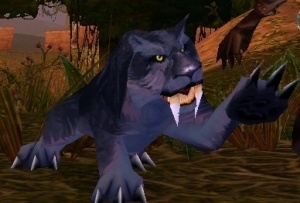

Jungle Panther: Panthers in World of Warcraft can be found in multiple jungle-esque locations in Azeroth, and panthers in Azeroth all have saber-tooth fangs. Specific mobs called Jungle Panthers can be found as level 29-48 enemies in the Lost Isles during a boss fight with the great panther King Bangalash. Despite being called a 'panther', the artwork depicts a night elf druid transformed into a panther, evident by the tattoos on the panther's eyes.





Stranglethorn Tiger: Tigers also all have saber-tooth fangs in World of Warcraft. Stranglethorn Tiger, is a level 25-26 mob found in Stranglethorn Vale, a location known for its large population of beasts and jungle trolls.


Scavenging Hyena: Hyenas patrol the barren wastelands of Kalimdor, and are often used as pets by the centaurs. No hyena mob in WoW is named 'Scavenging Hyena', though.


Savannah Highmane: Lions are also found in the grasslands and barrens of Azeroth, and the Savannah Highmane in particular are (frankly very weak) mobs found in the Northern Barrens. Also, unlike its appearance in Hearthstone, WoW's Savannah Highmane is coloured brown like a normal lion as opposed to the rarer black mane.

Captain's Parrot: Parrots are a type of non-hostile critter found in World of Warcraft, and, true to its name, many pirates do own parrots. Gotta keep up with the stereotype, right?



Other uncollectible beasts... Sheeps are critters that are generally harmless and found all over Warcraft III and World of Warcraft. Ditto Squirrels. Snakes tend to be enemies, although weaker compared to the larger and more dangerous hooded cobras. We'll cover Devilsaurs in the King Krush section of the legendaries. I think that's about it.

Captain's Parrot: Parrots are a type of non-hostile critter found in World of Warcraft, and, true to its name, many pirates do own parrots. Gotta keep up with the stereotype, right?



Other uncollectible beasts... Sheeps are critters that are generally harmless and found all over Warcraft III and World of Warcraft. Ditto Squirrels. Snakes tend to be enemies, although weaker compared to the larger and more dangerous hooded cobras. We'll cover Devilsaurs in the King Krush section of the legendaries. I think that's about it.
_____________________________________________________________
MECHS, CONSTRUCTS AND OTHERS:
Robots, golems, and a couple of things that don't really fit in any of the other classifications up above.

Mana Wyrm: Mana Wyrm are floating, tiny snake-like creatures made completely out of mana, and attracted to mana. The Mana Wyrms are iconically associated with the blood elven lands, although some are found in areas such as Suramar and Netherstorm. Mana Wyrms are added with the Burning Crusade expansion, iconically featured in its cinematic trailer, and are attracted to sources of high magic. One of the first Blood Elf starting quests involves having to slay a group of Mana Wyrms (specifically named such).

Acidic Swamp Ooze: Acidic Swamp Ooze is the name of a mob in Dustwallow Marsh in World of Warcraft. Oozes are creatures that, despite their shape, aren't elementals, but are considered 'Aberrations' -- things that don't quite fit into any other group of classification. They are blobs of chaotic matter that have been corrupted by the powers of chaos. Oozes apparently have a tendency to swallow goods and weaponry, something that the card's battlecry reflects.

Alarm-o-Bot: The Alarm-o-Bot are based on the mech of the same name in World of Warcraft. Alarm-o-Bots are walking, well, alarm systems that are invented by the gnomes, and are often seen in the abandoned gnomish town of Gnomeregan. While not hostile, they will shout out a warning and summon its masters if they spot an intruder (usually you), which is reflected to how it can't attack in Hearthstone, and summons a bigger minion from elsewhere.


Harvest Golem: Harvest Golem are giant mechanical scarecrows with daggers for fingers that patrol the land of Westfall, with specific level 10-12 mobs called 'Harvest Golem' found there. While there is debate on who is responsible for the creation of the Harvest Golem -- the Defias Brotherhood or just some crazy goblins -- the Harvest Golems are programmed to wipe out the human inhabitants of Westfall. There are two types of harvest golems -- the one that resembles a scarecrow (represented in the 'Harvest Golem' artwork) and one where the coverings are stripped down (represented in the 'Damaged Golem' artwork).






War Golem: Golems are lifeless, soulless, mindless creatures brought to life with magic. War Golems are first seen in various magical cities like Dalaran in Warcraft III, although they had a wildly different appearance, similar to a suit of armour with horns. In World of Warcraft, the term 'war golem' is often used to refer to the dwarven-esque stone machinations crafted by titans and titanic technology.The specific mob called War Golem is a level 46 mob in the Badlands.




Arcane Golem: Arcane Golems (also Crystal Golems) are robotic guardians created by blood elves. Powered by a mana crystal that holds their upper bodies aloft, Arcane Golems first came into existence around the time of Burning Crusade, where they are popularly seen in Blood Elven territory. Several other races, like the Draenei and the Nightborne, have their own arcane golems similar to that used by the Blood Elves.


Ancient Watcher: The Ancient Watcher is based on the Uldum Watchers, giant, living stone statues with Egyptian-esque garb that are found throughout the zone of Uldum. Many of these watchers are either inanimate statues or broken, but those that are living will rise up and challenge those who come near.
_________________________________________
Hearthstone and the World of Warcraft TCG:
A little bonus feature here now that we've cleaned up the length of this article... the Basic and Classic set of Hearthstone actually borrows a lot of artwork from the old World of Warcraft TCG, using artwork of some characters to represent other characters.
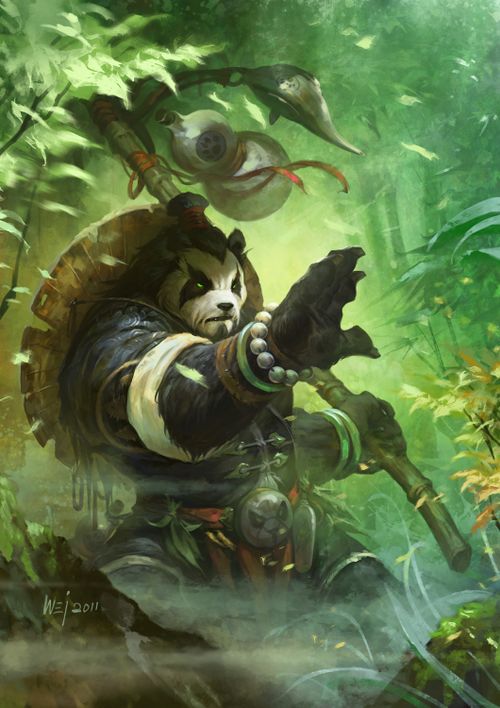

Youthful Brewmaster depicts Chen Stormstout, a legendary wandering brewmaster from the long-lost island of Pandaria. Longing for the world outside of Pandaria, Chen would eventually depart the shrouded mists that hid the Wandering Isle from the rest of the world. Chen would travel the world of Azeroth, looking for new sights and new ingredients with which he could make more brews, and would arrive on Durotar during the events of the founding of Orgrimmar. There, he met a fellow wanderer, the beastmaster Rexxar, who was running errands and assisting the foundling New Horde as they built their new capital city of Orgrimmar. After assisting Chen in gathering some exotic ingredients, Chen ended up joining Rexxar and his troll companion Rokhan in adventures in Durotar, leading to a huge confrontation against the Kul Tiras Armada in Theramore Island. Despite this, Chen maintained his independence for the years to come. Chen would star in the Mists of Pandaria expansion, alongside his niece Li-Li Stormstout, where they would assist Pandaria and the adventurers of both Alliance and Horde in defending Pandaria from threats both without and within, both new and old.
Since it's honestly just a matter of time before Chen gets a playable card in some way or form (and we're honestly just waiting if it's the monk class or a Pandaria-themed expansion) I'm not going into too much detail about Chen's lore.
_________________________________________
Hearthstone and the World of Warcraft TCG:
A little bonus feature here now that we've cleaned up the length of this article... the Basic and Classic set of Hearthstone actually borrows a lot of artwork from the old World of Warcraft TCG, using artwork of some characters to represent other characters.


Youthful Brewmaster depicts Chen Stormstout, a legendary wandering brewmaster from the long-lost island of Pandaria. Longing for the world outside of Pandaria, Chen would eventually depart the shrouded mists that hid the Wandering Isle from the rest of the world. Chen would travel the world of Azeroth, looking for new sights and new ingredients with which he could make more brews, and would arrive on Durotar during the events of the founding of Orgrimmar. There, he met a fellow wanderer, the beastmaster Rexxar, who was running errands and assisting the foundling New Horde as they built their new capital city of Orgrimmar. After assisting Chen in gathering some exotic ingredients, Chen ended up joining Rexxar and his troll companion Rokhan in adventures in Durotar, leading to a huge confrontation against the Kul Tiras Armada in Theramore Island. Despite this, Chen maintained his independence for the years to come. Chen would star in the Mists of Pandaria expansion, alongside his niece Li-Li Stormstout, where they would assist Pandaria and the adventurers of both Alliance and Horde in defending Pandaria from threats both without and within, both new and old.
Since it's honestly just a matter of time before Chen gets a playable card in some way or form (and we're honestly just waiting if it's the monk class or a Pandaria-themed expansion) I'm not going into too much detail about Chen's lore.
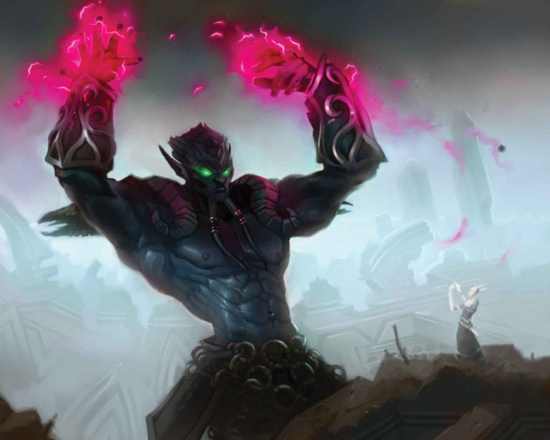

Blood Fury depicts Levixus, the Soul Caller, a level 66 eredar warlock introduced in Burning Crusade that stays in Auchindoun, having bound many of the dead spirits in the mausoleum to his will. He is noted to have been born a Draenei, but was twisted into his current Eredar form due to the corruption of the Burning Legion. His father, Nitrin the Learned, reluctantly asks an adventurer to help in slaying Levixus and destroying the Book of the Dead that Levixus uses to channel the vile magic that binds the dead souls to him.
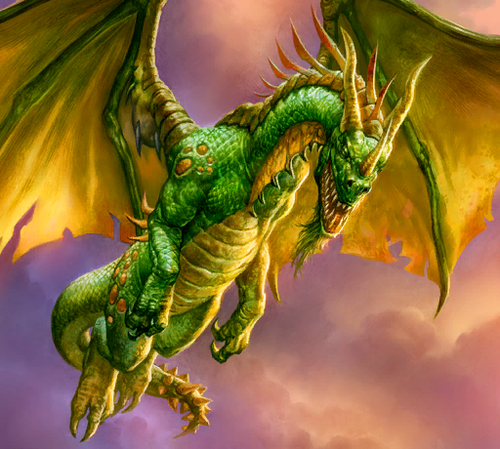

Emerald Drake depicts Eranikus, a mighty green dragon that is a consort to Ysera. Eranikus was tasked to guard the Temple of Atal'Hakkar in the Swamp of Sorrows, but while Eranikus and his band of dragons are able to destroy Hakkar's physical manifestation, Eranikus succumbed to a corruption within the Emerald Dream, and grew insane. Hakkar's troll cultists that survived then resumed their efforts to summon Hakkar. The Shade of Eranikus would serve as the fourth boss in the raid Temple of Atal'Hakkar, and Eranikus's essence would be trapped within a trinket, where it was passed on to the green dragon Itharius.
During the events leading up to the opening of Ahn'Qiraj, the adventurers and their dragon allies have to find the pieces of the Scepter of the Shifting Sands in order to open the Qiraji temple... but unfortunately, one of the shards was entrusted to Eranikus in centuries past. Eventually, with the aid of Keeper Remulos, a portal to the heart of the Emerald Dream is opened where the adventurer meets against Eranikus's essence in the Dream, which is still insane and under the control of the Old Gods. Eranikus and an army of phantasms fought against the adventurer and Keeper Remulos until the arrival of Tyrande Whisperwind, who channels the power of Elune to cleanse the corrupted dragon. Finally sane once more, Eranikus would return with Ysera to fight against the corruption in the Emerald Nightmare. In the novel Stormrage, Eranikus escaped to Azeroth for fear of corruption of the Emerald Nightmare, but a group of druids led by Tyrande Whisperwind found him. They were attacked by the corrupted dragons of nightmare Lethon and Emeriss, and the panicking Eranikus is finally convinced to fight for Ysera once more. Eranikus battled against Lethon while Malfurion freed Ysera from the tendrils of corruption, eventually sacrificing himself to defeat Lethon, pulling the nightmare dragon into the boundary between realms, which obliterated both dragons.
During the events leading up to the opening of Ahn'Qiraj, the adventurers and their dragon allies have to find the pieces of the Scepter of the Shifting Sands in order to open the Qiraji temple... but unfortunately, one of the shards was entrusted to Eranikus in centuries past. Eventually, with the aid of Keeper Remulos, a portal to the heart of the Emerald Dream is opened where the adventurer meets against Eranikus's essence in the Dream, which is still insane and under the control of the Old Gods. Eranikus and an army of phantasms fought against the adventurer and Keeper Remulos until the arrival of Tyrande Whisperwind, who channels the power of Elune to cleanse the corrupted dragon. Finally sane once more, Eranikus would return with Ysera to fight against the corruption in the Emerald Nightmare. In the novel Stormrage, Eranikus escaped to Azeroth for fear of corruption of the Emerald Nightmare, but a group of druids led by Tyrande Whisperwind found him. They were attacked by the corrupted dragons of nightmare Lethon and Emeriss, and the panicking Eranikus is finally convinced to fight for Ysera once more. Eranikus battled against Lethon while Malfurion freed Ysera from the tendrils of corruption, eventually sacrificing himself to defeat Lethon, pulling the nightmare dragon into the boundary between realms, which obliterated both dragons.


Azure Drake depicts Arygos, one of the leadership figures among the blue dragonflight. Arygos participated in the ancient War of the Shifting Sands, representing the blue dragonflight during the battle against the Qiraji. Arygos, alongside two others -- the red Caelestrasz and the green Merithra -- did a brave charge into the Qiraji legions, buying enough time for the night elf Fandral Staghelm and the bronze dragon Anachronos to finally seal the Qiraji with a magical barrier. Arygos and the other two were presumed slain, but they were instead captured for the next thousand years as prisoners of the Qiraji and their dread master, the Old God CThun. When Ahn'Qiraj was reopened during the events of World of Warcraft, agents of the dragonflights (who were unable to enter) tasked adventurers to enter the tomb and free their three imprisoned brethren.
 As of Burning Crusade, Arygos has returned back to the blue dragonflight's base, the Nexus, and bore witness to Malygos regaining his sanity. Arygos very eagerly supported Malygos's stance about how mortal races should not use arcane magic, treating non-draconic races with open content. Arygos survived the Nexus War where Malygos was slain, but was a heavy proponent of Malygos's xenophobic views. During the events of Cataclysm, Arygos and the younger Kalecgos represented the blue dragonflight in lieu of the slain Malygos, and Arygos made his contempt of Alexstrasza and the non-blue-dragons clear. Wyrmrest Temple soon came under attack by twilight dragons loyal to Deathwing, but it soon became clear that Arygos had cut a deal with Deathwing and his allies in order to ensure his own succession as the leader of the blue dragonflight. The increasingly-frustrated Arygos attempted and failed to kill Thrall, the condition that the twilight dragons had for assisting him, and Arygos then attempted to get rid of his rival Kalecgos as well. The entirety of the blue dragonflight would converge to choose a new dragon aspect, and as the two preached their respective views, but it was Kalecgos that was chosen by the dragonflight instead, being transformed by the light of the moons into the new Aspect of Magic. Arygos, bitter and angry, headed off to the Eye of Eternity, where he attempted to gather more allies, but Deathwing's agents instead slew Arygos, and the Twilight Father Benedictus used Arygos's potent blood to empower the five-headed twilight dragon Chromatus.
As of Burning Crusade, Arygos has returned back to the blue dragonflight's base, the Nexus, and bore witness to Malygos regaining his sanity. Arygos very eagerly supported Malygos's stance about how mortal races should not use arcane magic, treating non-draconic races with open content. Arygos survived the Nexus War where Malygos was slain, but was a heavy proponent of Malygos's xenophobic views. During the events of Cataclysm, Arygos and the younger Kalecgos represented the blue dragonflight in lieu of the slain Malygos, and Arygos made his contempt of Alexstrasza and the non-blue-dragons clear. Wyrmrest Temple soon came under attack by twilight dragons loyal to Deathwing, but it soon became clear that Arygos had cut a deal with Deathwing and his allies in order to ensure his own succession as the leader of the blue dragonflight. The increasingly-frustrated Arygos attempted and failed to kill Thrall, the condition that the twilight dragons had for assisting him, and Arygos then attempted to get rid of his rival Kalecgos as well. The entirety of the blue dragonflight would converge to choose a new dragon aspect, and as the two preached their respective views, but it was Kalecgos that was chosen by the dragonflight instead, being transformed by the light of the moons into the new Aspect of Magic. Arygos, bitter and angry, headed off to the Eye of Eternity, where he attempted to gather more allies, but Deathwing's agents instead slew Arygos, and the Twilight Father Benedictus used Arygos's potent blood to empower the five-headed twilight dragon Chromatus.


 As of Burning Crusade, Arygos has returned back to the blue dragonflight's base, the Nexus, and bore witness to Malygos regaining his sanity. Arygos very eagerly supported Malygos's stance about how mortal races should not use arcane magic, treating non-draconic races with open content. Arygos survived the Nexus War where Malygos was slain, but was a heavy proponent of Malygos's xenophobic views. During the events of Cataclysm, Arygos and the younger Kalecgos represented the blue dragonflight in lieu of the slain Malygos, and Arygos made his contempt of Alexstrasza and the non-blue-dragons clear. Wyrmrest Temple soon came under attack by twilight dragons loyal to Deathwing, but it soon became clear that Arygos had cut a deal with Deathwing and his allies in order to ensure his own succession as the leader of the blue dragonflight. The increasingly-frustrated Arygos attempted and failed to kill Thrall, the condition that the twilight dragons had for assisting him, and Arygos then attempted to get rid of his rival Kalecgos as well. The entirety of the blue dragonflight would converge to choose a new dragon aspect, and as the two preached their respective views, but it was Kalecgos that was chosen by the dragonflight instead, being transformed by the light of the moons into the new Aspect of Magic. Arygos, bitter and angry, headed off to the Eye of Eternity, where he attempted to gather more allies, but Deathwing's agents instead slew Arygos, and the Twilight Father Benedictus used Arygos's potent blood to empower the five-headed twilight dragon Chromatus.
As of Burning Crusade, Arygos has returned back to the blue dragonflight's base, the Nexus, and bore witness to Malygos regaining his sanity. Arygos very eagerly supported Malygos's stance about how mortal races should not use arcane magic, treating non-draconic races with open content. Arygos survived the Nexus War where Malygos was slain, but was a heavy proponent of Malygos's xenophobic views. During the events of Cataclysm, Arygos and the younger Kalecgos represented the blue dragonflight in lieu of the slain Malygos, and Arygos made his contempt of Alexstrasza and the non-blue-dragons clear. Wyrmrest Temple soon came under attack by twilight dragons loyal to Deathwing, but it soon became clear that Arygos had cut a deal with Deathwing and his allies in order to ensure his own succession as the leader of the blue dragonflight. The increasingly-frustrated Arygos attempted and failed to kill Thrall, the condition that the twilight dragons had for assisting him, and Arygos then attempted to get rid of his rival Kalecgos as well. The entirety of the blue dragonflight would converge to choose a new dragon aspect, and as the two preached their respective views, but it was Kalecgos that was chosen by the dragonflight instead, being transformed by the light of the moons into the new Aspect of Magic. Arygos, bitter and angry, headed off to the Eye of Eternity, where he attempted to gather more allies, but Deathwing's agents instead slew Arygos, and the Twilight Father Benedictus used Arygos's potent blood to empower the five-headed twilight dragon Chromatus. 

Darkscale Healer depicts Lady Sira'kess, one of the naga leaders in Vashj'ir. Lady Sira'kess is a quest-giver that will ask adventurers to help the naga fight against the Kvaldir invaders, but eventually, over the course of the Vashj'ir storyline, Sira'kess would face off against the heroes of the Alliance and Horde under Lady Naz'jar's orders, and would be slain.
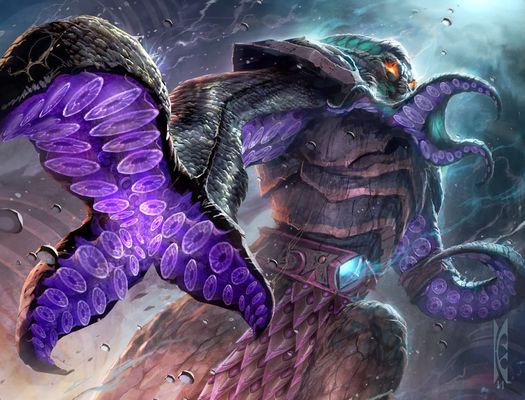

Faceless Manipulator depicts Commander Ulthok, the Festering Prince, the second boss in the Throne of the Tides raid, part of the forces sent by the Old Gods to invade Neptulon's realm. Commander Ulthok arrives immediately fter the fall of the first boss, the naga sea witch Lady Naz'jar, but would ultimately be slain by the adventurers. Ulthok uses the third Faceless One model, with an octopus face and a large, spherical head.


Sea Giant depicts Lord Arkkoroc, a level 60 sea giant quest-giver located in the Temple of Arkkoran in Azshara. The locals style Lord Arkkoroc as a lesser deity, and a temple is erected to worship him. Arkkoroc is constantly at war with the mighty hydra Hetaera, which has killed many of Arkkoroc's sons. Upon assisting Arkkoroc, the sea giant would aid the adventurer in slaying Razelikh the Defiler, a dreadlord, telling adventurers of the true name of Razelikh and part of the weapon required in slaying him. As of Cataclysm, however, Arkkoroc has apparently been killed, with the only trace of him being the Heart of Arkkoroc, an artifact used by the local naga to bend the remainder of Arkkoroc's children to their will.
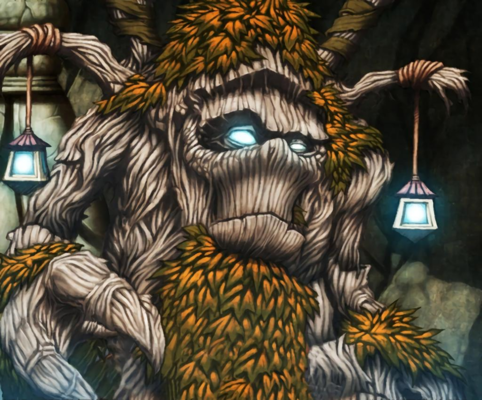

Ironbark Protector depicts Treebole, a Draenor Ancient that was introduced in Burning Crusade, located in Raven's Wood in Blade's Edge Mountains. Treebole is one of the few Ancients in the area to not be affected by the curse of evil spirits unleashed by the Girshna faction of Arakkoa, and adventurers seek Treebole's aid in ridding the spirits of the possessed Stonebark Ancients of the area.


Damaged Golem depicts Foe Reaper 5000, the third boss of the new Deadmines raid, an elite harvest golem that is the upgraded version of the Foe Reaper 4000 that wanders Westfall. Intended to be unleashed upon Stormwind City's soldiers, adventurers attacked the new Defias's base, and the Foe Reaper 5000 was unleashed upon these adventurers. In Legion, apparently the Burning Legion found the broken form of the Foe Reaper 5000 and reconstructed it into the 'Reconstructed Fel Reaper 5000', where it is one of the Legion's agents as they invaded Westfall.


King Krush depicts Lar'korwi in WoW... although the card art depicts a blue Devilsaur, whereas Lar'kowi was a blue ravasaur, a far smaller type of dinosaur. Mind you, this artwork isn't exactly accurate for WoW's King Krush either, which was a green Devilsaur. In WoW, Lar'korwi is the mightiest of Un'goro's Ravasaur population, and the tauren hunter Torwa Pathfinder tasks adventurers to hunt down the mighty beast, drawing him out from his lair near the Eastern Crystal Pylon and eventually slaying it.



Captain's Parrot depicts Skywing. Skywing is an Arakkoa (a bird-man) cursed into a white parrot by his rival, Luanga the Imprisoner, for attempting to spread the way of the Light among the Arakkoa people. While trapped in his parrot form, Skywing attempted to seek out help, eventually attracting the attention of an adventurer who escorted Skywing to find Luanga, defeat Luanga, and return Skywing back into his original form.


The Uproot choice card for Ancient of War depicts Ivus, the Forest Lord, an Ancient of War that Alliance players are able to summon for their side in the PvP region of Alterac Valley.
Pit Lord (as well as Crush from GvG) depicts Maghteridon, one of the more well-known members of the Pit Lord race. Magtheridon was one of the more memorable bosses in Warcraft III: The Frozen Throne during Illidan's takeover of Outland, and later a boss in Burning Crusade. Magtheridon would eventually receive a card of his own in Ashes of Outland.
Malygos depicts his son and eventual successor as Aspect of Magic, Kalecgos. We'll cover Kalecgos proper when he gets a card in the expansion Rise of Shadows.
Molten Giant depicts Golemagg the Incinerator, a mighty Molten Giant that serves as one of the raid bosses in Molten Core. Golemagg would appear in some Blackrock Mountain themed Tavern Brawls, and we will cover him there.


The Uproot choice card for Ancient of War depicts Ivus, the Forest Lord, an Ancient of War that Alliance players are able to summon for their side in the PvP region of Alterac Valley.
Ogre Magi depicts Mogor the Ogre,
a mad ogre and the treacherous leader of the Laughing Skull Clan, and a
prolific participant of the Second War, eventually betraying the Horde
to the Alliance to help take out Gul'dan. Mogor would receive a proper
card of his own in Goblins vs. Gnomes, and we'll properly talk about him
later.
Malygos depicts his son and eventual successor as Aspect of Magic, Kalecgos. We'll cover Kalecgos proper when he gets a card in the expansion Rise of Shadows.
Molten Giant depicts Golemagg the Incinerator, a mighty Molten Giant that serves as one of the raid bosses in Molten Core. Golemagg would appear in some Blackrock Mountain themed Tavern Brawls, and we will cover him there.
No comments:
Post a Comment